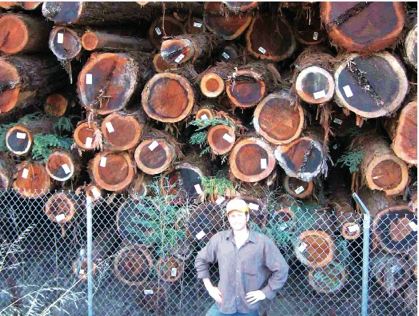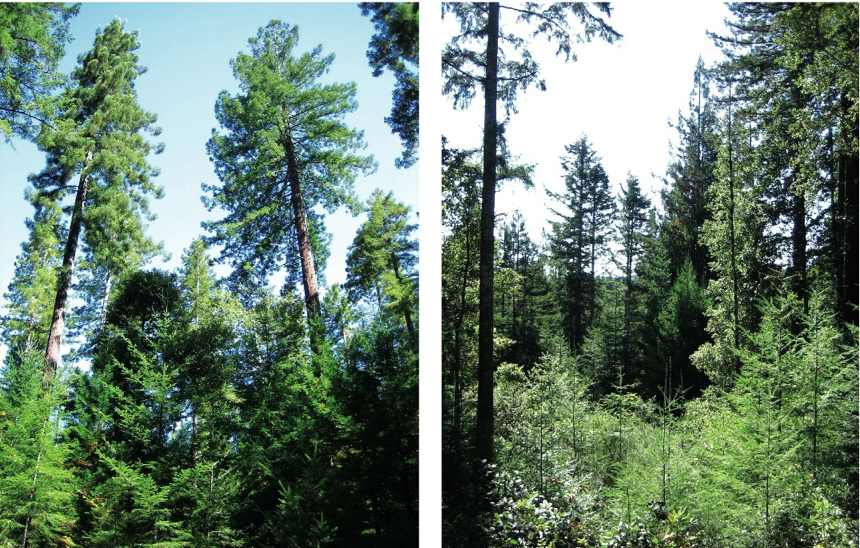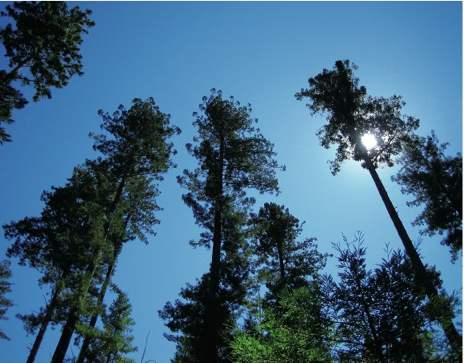Redwood in California: An overview of silvicultural systems
John-Pascal Berrill and Kevin L O’Hara, New Zealand Tree Grower February 2007.
Coast redwood is among the most unique of the world’s commercial conifers. Its natural range is confined to a relatively narrow fog belt along California’s coast. What really separates this tree from other conifers is the ability to produce sprouts from roots, the stem, branches and even a broken top.
This can be a blessing, providing regeneration in recently cutover stands where sprout regeneration occurs quickly and is virtually guaranteed. Unfortunately, redwood regenerates very poorly from seed. Although a disturbed or cutover area will often support natural seedling regeneration, it is rare in an established stand to find redwood seedlings.
Dealing with regeneration from stumps

One of the great conundrums of redwood silviculture is that even though the species regenerates well from stump sprouts, these are limited to the locations of previous stumps. In harvested old growth stands with well under 100 stems per hectare, this typically leaves large gaps between stumps and very clumpy distributions of trees. Sprout clumps may contain over 100 sprouts from a single stump after harvest. These sprouts self thin to more manageable numbers, but it is common to have 10 to 20 sprouts from a single stump 40 years after harvest.
Managers of even-aged stands will often supplement the natural sprout regeneration with planted seedlings. These seedlings do not grow as fast as the stump sprouts initially, but once established can grow quickly, and they form a valuable regeneration source for future rotations. Often these plantings are mixtures of redwoods and Douglas fir. Pre-commercial thinning is frequently necessary because of variable spacings of trees in young even-aged stands.
Thinning to waste prescriptions usually favour redwood by thinning out competing species, and reducing crowding in clumps of redwood stump sprouts, such as thinning to keep the three best redwood sprouts per stump, and a spacing of four metres between other trees. Sprouts originating from lower on the stump are favoured over sprouts high on stumps whose stability is compromised as the stump decays.

Focus on volume production
Pruning for clearwood production is uncommon, and can result in prolific epicormic sprouting if pruning is severe. There is limited chemical usage, mainly ‘hack and squirt’ or foliar treatments reducing competition from hardwoods. Commercial thinning is common.
Harvesting is severely restricted adjacent to streams where forestry practice regulations protect water quality.
The main focus of redwood management is on volume production. Little consideration is given to wood quality, or the influence of silviculture on clearwood or heartwood production.
The maximum size of log processed by sawmills has decreased since harvesting shifted from old growth to second-growth stands. However some smaller mills can still process large logs from remnant old growth trees.

Coast redwood stands can be very productive depending on stocking and site quality. A typical site on industrial land might produce a mean annual volume increment of 9.5 to 26 cubic metres per hectare per year. Productivity can be considerably higher with good stocking on better sites. Data from one forest showed that, at lower stockings, average diameter growth over a 20-year period from age 60 to 80 can exceed 1.5 cm a year, but more commonly ranges from 0.5 cm to one centimetre a year. Diameter growth in unthinned stands was lower on average, even among dominant trees. A thinning study found that stands with half of basal area removed quickly returned to a similar rate of productivity as unthinned stands, but there were many fewer trees, resulting in greater diameter growth.
California forest practice regulations limit even-aged rotations to no less than 50 years.
Multi-aged management

Multi-aged management is gaining popularity as a means of wood production that maintains continuous forest cover. Various forms of multi-aged management are used in California, including seed tree, shelterwood, variable retention, individual tree selection and group selection. Individual tree selection results in regeneration spread in between residual trees. The partial harvesting must remove enough big trees to leave growing space for both the new trees and for residual trees expanding their crowns in all directions.
Group selection involves clearing small areas while keeping the residual stand, the matrix, intact and sometimes thinned. The residual trees mainly expand their crowns into the group areas leaving relatively more growing space provided that the cut area is large enough. Smaller groups with widths of half a tree height or less appear to get filled with expanding residual tree crowns, suppressing regeneration below.
Variable retention system
Variable retention is a flexible management system. Residual trees are retained in groups or dispersed throughout the stand, for habitat preservation, soil conservation and wood production. Once the new trees have reached merchantable size, residual trees may be harvested or retained through successive partial harvests. A new growth model – redwood MASAM – was used to compare variable retention regimes in California.
Models of some multi-age regimes

An example regime designed using the redwood MASAM model involves a two-aged selection system producing trees with a diameter at breast height of approximately 60 centimetres. When the older group of 200 stems per hectare was removed entirely during partial harvesting, extra trees in the younger group were thinned to leave the best 200 stems per hectare.
A three-aged regime was also designed to produce trees with a DBH of 60 cm. When the oldest at 125 stems per hectare were removed, they were replaced by the middle cohort thinned from 175 stems per hectare to 125 stems, and with a DBH of approximately 41 cm. The middle cohort was replaced by the youngest, with a DBH of approximately 22 cm. In these examples, the three-aged system has a shorter cutting cycle. Each harvest reduces stand basal area by around 70% in the three-aged system, and 80% in the two- aged system. This free growing space is needed to maintain growth until the next harvest.
Careful allocation of growing space
Extra trees are kept in younger cohorts to insure against damage and mortality, and cut at the time of partial harvesting leaving the target number of trees. Keeping too many trees in the understory wastes valuable growing space on trees that will probably never become merchantable trees. Generally, having more cohorts means greater forest cover over time, However there are probably fewer trees in each cohort, with less growing space available, and shorter cutting cycles with greater potential for site and residual stand damage from more frequent harvests.
Management regimes can be designed to meet specific owner objectives such as target tree size or timing of cash flows from partial harvesting. The key is careful allocation of growing space to trees. The most common pitfall in California is not cutting hard enough. Residual tree crowns expand to occupy the growing space, suppressing and in some cases killing stump sprouts needed to sustain the multi-aged structure.
Pascal Berrill is currently studying under Dr Kevin O’Hara, Professor of Silviculture, at the University of California.
Stand density index – a useful tool for New Zealand redwood plantings
Measuring growing space occupancy in redwoods is not new. In 1933, a researcher named Reineke reported data for even-aged stands in California, presenting a stand density index for various species.
He found that stands reach an upper limit of stocking relating to average tree size. This concept can be used to define maximum final crop stockings for a target average tree size. For example, when all growing space is occupied in even-aged redwood stands, there is only space for approximately 800 stems per hectare with an average diameter at breast height (DBH) of 50 cm. Alternatively, there is space for 600 stems per hectare with an average DBH of 60 cm, or 475 stems at 70 cm DBH.
Lower stocking makes less complete use of available growing space but may be needed to satisfy other objectives, such as keeping lower branches alive longer or producing trees of uniform size. Intense competition during the rotation creates winners and losers, giving a wider range of diameters at harvest.
The stand density index concept of stocking control should be transferable to New Zealand plantations. Data from one particular redwood stand in New Zealand show that this stand is only at 75% of the upper limit of the US stand density, with 200 stems per hectare and an average DBH of 100 cm, yet a very wide spread of diameters exists. This implies that 75% of maximum stand density index may be a sensible upper limit for wood production in New Zealand. This would be 360 stems per hectare at 70 cmDBH, 460 stems per hectare at 60 cm and a maximum of 620 stems per hectare to achieve a 50 cm average DBH.
The maximum stand density index for redwoods is higher than the stand density index for most species due to the shade tolerance of redwood, the thick bark, and lack of stocking related pests. The stand density index for a whole stand can be divided into stand density index for each group of multi-aged stands, proving to be a useful concept for stocking control in even-aged and multi-aged plantations and natural stands.

 Farm Forestry New Zealand
Farm Forestry New Zealand